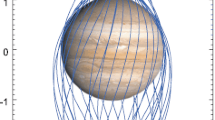Abstract
Two attitude determination algorithms developed by Paul Davenport in 1965 are examined. The algorithms use two direction measurements to estimate attitude using the Rodrigues vector representation. A complete error, covariance and singularity analysis of both algorithms is performed. The results are verified numerically and compared to other attitude determination algorithms.
Similar content being viewed by others
References
Davenport, P. B. “A Vector Approach for the Algebra of Rotations,” NASA X-514-71-312, November 1965.
Davenport, P.B. “A Vector Approach for the Algebra of Rotations with Applications,” NASATN-D-4696, August 1968.
Wahba, G. “Problem 65-1: A Least Squares Estimate of Spacecraft Attitude,” Siam Review, Vol. 7, No. 3, July 1965, pp. 409.
Shuster, M.D. “A Survey of Attitude Representations,” The Journal of the Astronautical Sciences, Vol. 41, No. 4, October–December 1993, pp. 439–517.
Davenport, P.B. “Rotations about Nonorthogonal Axes, ” AIAA Journal, Vol. 11, No. 6, June 1973, pp. 853–857.
Shuster, M. D. and Markley, F. L. “Generalization of the Euler Angles,” The Journal of the Astronautical Sciences, Vol. 51, No. 2, April–June 2003, pp. 123–132.
Keat, J. Analysis of Least Squares Attitude Determination Routine DOAOP, Computer Sciences Corporation, CSC/TM-77/6034, February 1977.
Shuster, M.D. and Oh, S.D. “Three-Axis Attitude Determination from Vector Observations,” Journal of Guidance and Control, Vol. 4, No. 1, January-February 1981, pp. 70–77.
Davenport, P.B. and Welter, G.L. “Algorithm for In-Flight Gyroscope Calibration,” Proceedings of the Flight Mechanics/Estimation Theory Symposium, NASA Goddard Space Flight Center, Greenbelt, Maryland, September 1988, pp. 114–127.
Markley, F. L. and Mortari, D. “Quaternion Attitude Estimation Using Vector Measurements,” The Journal of the Astronautical Sciences, Vol. 48, Nos. 2 and 3, April–September 2000, pp. 359–380.
Black, H. D. “A Passive System for Determining the Attitude of a Satellite,” AIAA Journal, Vol. 2, July 1964, pp. 1350–1351.
Markley, F. L. “Attitude Estimation Using Two Vector Measurements,” Proceedings of the Flight Mechanics Symposium, NASA Goddard Space Flight Center, Greenbelt, Maryland, May 1999, NASA Conference Publication NASA/CP-19989-209235, pp. 39–52.
Markley, F.L. “Fast Quaternion Attitude Estimation from Two Vector Measurements,” Journal of Guidance, Control and Dynamics, Vol. 25, No. 2, March–April 2002, pp. 411–414.
Mortari, D. “Second Estimator for the Optimal Quaternion,” Journal of Guidance, Control and Dynamics, Vol. 23, No. 4, September–October 2000, pp. 885–888.
Shuster, M. D. and Natanson, G. A. “Quaternion Computation from a Geometric Point of View,” The Journal of Astronautical Sciences, Vol. 41, No. 4, October–December 1993, pp. 454–556.
Shuster, M.D. “Maximum Likelihood Estimation of Spacecraft Attitude,” The Journal of the Astronautical Sciences, Vol. 37, No. 1, January–March 1989, pp. 79–88.
Wertz, J.R. (editor) Spacecraft Attitude Determination and Control ed., Kluwer Academic Publishers, Dordrecht, 1978.
Tanygin, S. and Shuster, M. D. “The Many TRIAD Algorithms,” presented as paper AAS-07-104 at the AAS/AIAA 17th Space Flight Mechanics Meeting, Sedona, Arizona, January 28–February 2, 2007; Advances in the Astronautical Sciences, Vol. 127, 2007, pp. 81–99.
Mortari, D., Angelucci, M., and Markley, F.L. “Singularity and Attitude Estimation,” presented as paper AAS-00-130 at the AAS/AIAA Space Flight Mechanics Meeting, Clear-water, Florida, January 2000; Advances in the Astronautical Sciences, Vol. 105, 2000, pp. 479–493.
Mortari, D., Markley, F. L., and Junkins, J. L. “Optimal Linear Attitude Estimator of Spacecraft Attitude (OLAE),” presented as paper AAS-00-129 at the AAS/AIAA Space Flight Mechanics Meeting, Clearwater, Florida, January 2000; Advances in the Astronautical Sciences, Vol. 105,2000,465–477.
Mortari, D., Markley, F. L., and Singla, P. “Optimal Linear Attitude Estimator,” Journal of Guidance, Control and Dynamics, Vol. 30, No. 6, November–December 2007, pp. 1619–1627.
Author information
Authors and Affiliations
Corresponding author
Additional information
To F. Landis Markley and Paul B. Davenport, some of the most creative practitioners of attitude.
Rights and permissions
About this article
Cite this article
Tanygin, S. Error Analysis of the Rodrigues Vector Estimators Using Two Direction Measurements. J of Astronaut Sci 57, 149–165 (2009). https://doi.org/10.1007/BF03321499
Published:
Issue Date:
DOI: https://doi.org/10.1007/BF03321499




